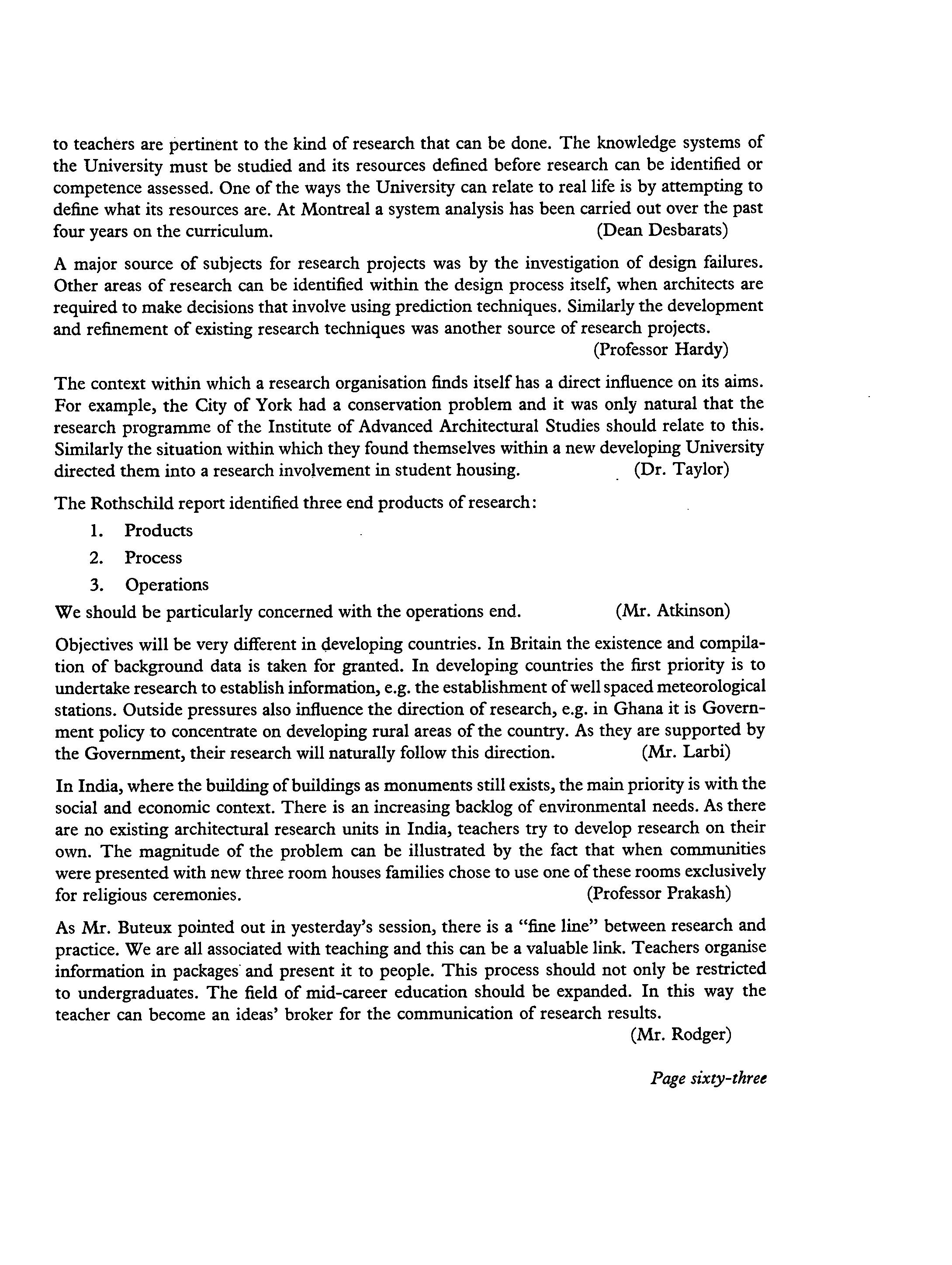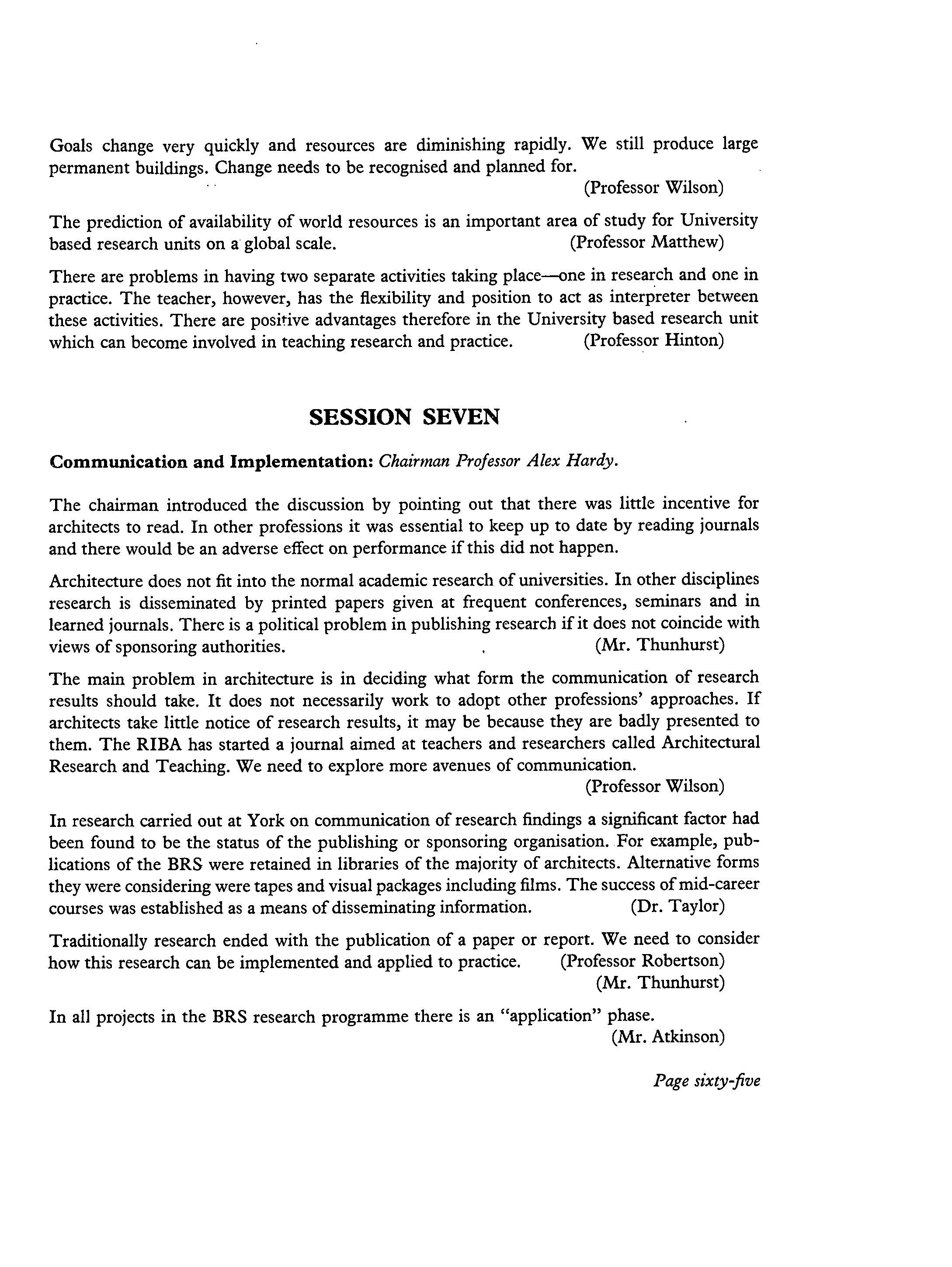
5 minute read
Session 7: Communication and Implementation
to teachers are pertinent to the kind of research that can be done. The knowledge systems of the University must be studied and its resources defined before research can be identified or competence assessed. One of the ways the University can relate to real life is by attempting to define what its resources are. At Montreal a system analysis has been carried out over the past four years on the curriculum. (Dean Desbarats) A major source of subjects for research projects was by the investigation of design failures. Other areas of research can be identified within the design process itself, when architects are required to make decisions that involve using prediction techniques. Similarly the development and refinement of existing research techniques was another source of research projects. (Professor Hardy) The context within which a research organisation finds itself has a direct influence on its aims. For example, the City of York had a conservation problem and it was only natural that the research programme of the Institute of Advanced Architectural Studies should relate to this. Similarly the situation within which they found themselves within a new developing University directed them into a research involvement in student housing. (Dr. Taylor) The Rothschild report identified three end products of research: Products Process Operations We should be particularly concerned with the operations end. (Mr. Atkinson) Objectives will be very different in developing countries. In Britain the existence and compilation of background data is taken for granted. In developing countries the first priority is to undertake research to establish information, e.g. the establishment of well spaced meteorological stations. Outside pressures also influence the direction of research, e.g. in Ghana it is Government policy to concentrate on developing rural areas of the country. As they are supported by the Government, their research will naturally follow this direction. (Mr. Larbi) In India, where the building of buildings as monuments still exists, the main priority is with the social and economic context. There is an increasing backlog of environmental needs. As there are no existing architectural research units in India, teachers try to develop research on their own. The magnitude of the problem can be illustrated by the fact that when communities were presented with new three room houses families chose to use one of these rooms exclusively for religious ceremonies. (Professor Prakash) As Mr. Buteux pointed Out in yesterday's session, there is a "fine line" between research and practice. We are all associated with teaching and this can be a valuable link. Teachers organise information in packages and present it to people. This process should not only be restricted to undergraduates. The field of mid-career education should be expanded. In this way the teacher can become an ideas' broker for the communication of research results. (Mr. Rodger)
Page sixty-three
Advertisement
A continuum needs to be established with a well defined knowledge system. At Montreal the main areas were: Physical environment Man environment Planning theories Techniques of control Materials Processes Methodology Communication These were knowledge, not problem based areas. (Dean Desbarats) Feedback in architecture is inadequate. It is expensive to obtain and there is no provision within normal architects' fees and commissions for it. Feedback on a large scale needs organising on a national scale. This should be one area of active involvement by research units in Schools of Architecture. To be effective the time scale in obtaining feedback is critical. The feedback process is as important for the profession as a whole as it is to the individual practice. The collection and dissemination of shared information should be given a high priority. (Professor Hardy) (Professor Matthew) (Professor Wilson) (Dean Howarth) (Professor Robertson) Building regulations should evolve from feedback and require to be approached from an intellectual basis. Regulations should be positive statements developing from academic and research practice. Clear goals and objectives of regulations within a local framework require to be established. Research into aspects of Building Regulations needs encouraging and expanding. (Professor Wilson) (Professor Matthew) (Dr. Hawkes) (Mr. King) (Mr. Atkinson) Within Australia, research into Building Regulations is a popular field in all Schools of Architecture. It is considered an important area, possibly because the responsibility for regulations rests with state authorities and there is a wide variation of control. (Mr. King) There is a need to broaden the base of our education. We should be constantly seeking to improve our environment and questioning the role of the architect in this activity. What are the objectives of the environmental designer? The identification of goals are two prime objectives. (Mr. King)

Page sixty-four
Goals change very quickly and resources are diminishing rapidly. We still produce large permanent buildings. Change needs to be recognised and planned for.
(Professor Wilson) The prediction of availability of world resources is an important area of study for University based research units on a global scale. (Professor Matthew) There are problems in having two separate activities taking place—one in research and one in practice. The teacher, however, has the flexibility and position to act as interpreter between these activities. There are positive advantages therefore in the University based research unit which can become involved in teaching research and practice. (Professor Hinton)
SESSION SEVEN
Communication and Implementation: Chairman Professor Alex Hardy.
The chairman introduced the discussion by pointing out that there was little incentive for architects to read. In other professions it was essential to keep up to date by reading journals and there would be an adverse effect on performance if this did not happen. Architecture does not fit into the normal academic research of universities. In other disciplines research is disseminated by printed papers given at frequent conferences, seminars and in learned journals. There is a political problem in publishing research if it does not coincide with views of sponsoring authorities. (Mr. Thunhurst) The main problem in architecture is in deciding what form the communication of research results should take. It does not necessarily work to adopt other professions' approaches. If architects take little notice of research results, it may be because they are badly presented to them. The RIBA has started a journal aimed at teachers and researchers called Architectural Research and Teaching. We need to explore more avenues of communication. (Professor Wilson) In research carried out at York on communication of research findings a significant factor had been found to be the status of the publishing or sponsoring organisation. For example, publications of the BRS were retained in libraries of the majority of architects. Alternative forms they were considering were tapes and visual packages including films. The success of mid-career courses was established as a means of disseminating information. (Dr. Taylor) Traditionally research ended with the publication of a paper or report. We need to consider how this research can be implemented and applied to practice. (Professor Robertson) (Mr. Thunhurst) In all projects in the BRS research programme there is an "application" phase. (Mr. Atkinson)

Page sixty-five










